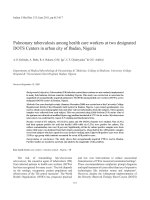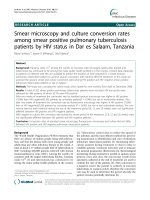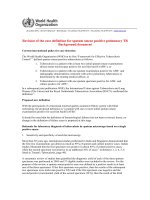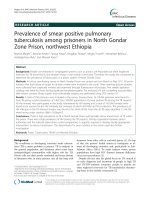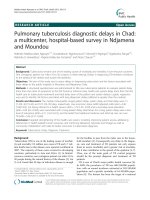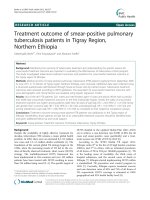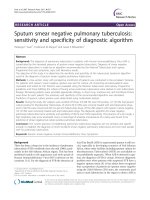Prevalence of smear positive pulmonary tuberculosis among prisoners in North Gondar Zone Prison, northwest Ethiopia doc
Bạn đang xem bản rút gọn của tài liệu. Xem và tải ngay bản đầy đủ của tài liệu tại đây (183.06 KB, 7 trang )
RES E AR C H A R T I C L E Open Access
Prevalence of smear positive pulmonary
tuberculosis among prisoners in North Gondar
Zone Prison, northwest Ethiopia
Beyene Moges
1*
, Bemnet Amare
2
, Fanaye Asfaw
3
, Wogahta Tesfaye
4
, Moges Tiruneh
3
, Yeshambel Belyhun
1
,
Andargachew Mulu
5
and Afework Kassu
3
Abstract
Background: People concentrated in congregated systems, such as prisons, are important but often neglected
reservoirs for TB transmission, and threaten those in the outside community. Therefore, this study was conducted to
determine the prevalence of tuberculosis in a prison system of North Gondar Zone.
Methods: An active case-finding survey in North Gondar Prison was carried out from March to May 2011. All prison
inmates who had history of cough for at least a week were included in the study. Three morning sputum samples
were collected from suspected inmates and examined through fluorescen ce microscopy. Fine needle aspiration
cytology was done for those having significant lymphadenopathy. Pre and post HIV test counseling was provided
after written consent. Binary logistic and multivariable analysis was performed using SPSS version 16.
Results: A total of 250 prisoners were included in the survey. Among these, 26 (10.4%) prisoners were found to
have TB giving a point prevalence of 1482.3 per 100,000 populations of smear positive TB among the TB suspects.
All the inmates who participated in the study volunteered for HIV testing and a total of 19(7.6%) inmates were
found to be reactive for the HIV antibody test amongst of which 9(47.4%) had TB co-infection. The prevalence of
HIV infection in the TB infected inmates was found to be 34.6% (9/26). From the 26 TB cases identified 12 (46.2%)
were having under nutrition (BMI < 18.5kg/m
2
).
Conclusions: There is hig h prevalence of TB in North Gondar Prison with possible active transmission of TB within
the prison. There was a high prevalence of HIV among the TB suspects. Strong cooperation between prison
authorities and the national tuberculosis control programmes is urgently required to develop locally appropriate
interventions to reduce transmission. The determinants for poor nutrition in the prison need also further
investigation.
Keywords: Prison, Tuberculosis, TB/HIV co-infection, Ethiopia
Background
The conditions in developing countries make tubercu-
losis (TB) a major problem in prisons. TB is endemic in
the general population, and detainees often come from
underprivileged communities with higher risk for TB.
Prison cells are often poorly ventilated and house dozens
of detainees who, in many prisons, mix all day long with
detainees from other cells in enclosed spaces [1]. On top
of this, the prisons’ health system is inadequate in al-
most all developing countries and, particularly in Sub-
Saharan Africa (SSA). To make matters worse, prison
populations have high HIV (human immune deficiency
virus) sero-prevalences [1].
Despite the fact that the global focus on TB control is
on early diagnosis and treatment of people in high TB
and TB/HIV-endemic countries, people in prisons are
often neglected reservoirs for TB transmission threaten-
ing those in the outside community [2].
* Correspondence:
1
Department of Immunology and Molecular Biology, School of Biomedical
and Laboratory Sciences, College of Medicine and Health Sciences, University
of Gondar, P.O.BOX 196, Gondar, Ethiopia
Full list of author information is available at the end of the article
© 2012 Moges et al.; licensee BioMed Central Ltd. This is an Open Access article distributed under the terms of the Creative
Commons Attribution License ( which permits unrestricted use, distribution, and
reproduction in any medium, provided the original work is properly cited.
Moges et al. BMC Infectious Diseases 2012, 12:352
/>Most TB surveys in prisons showed high TB preva-
lence rates ranging from 156.2/100,000 to 6500/100,000
[2-6]. As expected, there was a very high rate of HIV co-
infection in many of the studies, ranging from 26% in
Tanzania to 73% in Malawi [7,8]. Generally, the preva-
lence of TB in SSA prisons is estimated to be 6–30 times
higher than that in the general population [9]. The TB
prevalence rate in Zambian prisons in one study was
about 10 times that of the outside population [10].
The point prevalence of pulmonary TB in three major
prison settings of Eastern Ethiopia was 1913 per
100,000, about seven times higher than that of the gen-
eral population [11]. As there are no studies conducted
in the prisons of the Northwestern part of Ethiopia, this
study was planned to investigate the prevalence of TB
among prison inmates and the risk factors associated
with increased transmission in this area.
Methods
Study design, area and period
A cross sectional study was conducted in North Gondar
Zone Prison between March and May 2011 to deter-
mine the prevalence of TB. The prison is located in the
historic city of Gondar. It accommodates thousands of
inmates every year and is one of the major prisons in
North Gondar Zone. It had 1754 inmates during this
survey. The prison has a clinic for the prisoners and
the prison staff. It is meant for the diagnosis and treat-
ment of infectious and non infectious diseases. It also
provides service for the diagnosis and treatment of TB
and HIV.
Specimen collection and processing
A structured and pretested questionnaire was used to
collect socio-demographic and relevant clinical data of
the stud y subjects by physicians.
Sputum microscopy
Three morning sputum samples were collected from
patients having cough of at least 1 week duration.
Sputum-smear microscopy using a light emitting diode
(LED) fluorescence microscopy was do ne at Gondar
University Hospital Laboratory on the day of collection
following the manufacturer’s procedures (PARTEC
GmbH). Two slides were stained for every sample and
the slides were read by two experienced microbiologists
separately. Whene ver there were discordant results, a
third expert microbiologist read the slides and the report
of the third reader was taken as final. Smear positivity
was defined as the pres ence of at least one positive
smear result using the LED microscopy; this was used to
put them on treatment.
Fine needle aspiration cytology
All the TB suspects were screened for the presence of
lymphadenopathy both subjectively and objectively by
physicians. Fine needle aspiration cytology (FNAC) was
performed by a pathologist for patients having signi-
ficant lymphadenopathy (lymph nodes greater than
1x1cm in size). The slides were stained with Wrigh t
stain and TB was diagnosed by the presence of epithe-
loid granuloma and necrosis. The results were read by
an experienced pathologist at the University of Gondar,
Department of Pathology.
Blood collection, serum separation and HIV serology
To determine the HIV serostatus of the TB suspected
inmates, pre-test counseling was provided to the volun-
teer prisoners by a trained physician. Whole blood was
collected from prison inmates. Serum was separated by
centrifugation within 2h of collection and kept at -20°C
until used. The presence of HIV antibodies was deter-
mined by an enzyme-linked immunosorbent assay (ELISA)
following the manufacturer’s i nstruction (Vironostica HIV
Uni-Form II plus O, Organon Teknika, Boxtel, the Nether -
lands). After testing, the prisoners were provided with post
testing c ounsel ing b y t he coun selor. To assure confidenti-
ality of test results, only code numbers were used to i den-
tify serum of prisoners.
Nutritional assessment
Body weight was determined to the nearest 0.1 kg on an
electronic digital scale and height was measured to the
nearest 0.1 cm. Body mass index (BMI), defined as
the weight in kilogram of the individual divided by
the square of the height in meter, was used to deter-
mine the nutritional status of the patients into severe
malnutrition (BMI < 15.9 kg/m
2
), moderate malnutri-
tion (BMI = 16–16.9 kg/m
2
), mild malnutrition (BMI =
17–18.4 kg/m
2
) and normal (BMI = 18.5-25 kg/m
2
)as
recommended by WHO [12].
Statistical analysis
The collected data wa s computerized using excel pro-
gram, cleaned and exported to be analyzed by SPSS ver-
sion 16 (SPSS, Inc., Chicago, IL, USA). Means and
standard deviations were calculated for continuous vari-
ables using this software while crude and adjusted Odds
ratios (OR) were calculated to check statistical associ-
ation between the dependent and independent variables
using the binary logistic regression and multivariable
logistic regression models. All variab les of the study
were initially tested for association with smear positiv-
ity by using the binary logistic regression model. Those
which showed statistical association with sput um posi-
tivity by the logistic regression model were put in the
multivariable analysis model to check if the association
Moges et al. BMC Infectious Diseases 2012, 12:352 Page 2 of 7
/>existed after controlling against all the rest of the
variables.
Ethical issue
The study was conducted after ethical approval was
obtained from Institutional Review Board of the Univer-
sity of Gondar and after informed consent was obtained
from study subjects. Positive patients for TB and/or HIV
were treated by the prison staff following the nation’s
standard clinical management protocols.
Results
There were a total of 250 prison inmates with cough of
more than one week duration and all were included in
the survey. Table 1 shows distribution of TB positivity
among different sociodemograhic characteristics of the
prison inmates. A total of 26 (10.4%) inmates were found
to have TB during the survey using LED microscopy.
Three of them also had lymph node TB. The point
prevalence of TB in the prison was then calculated to be
1482.3 per 100,000 populations among the TB suspects.
The mean number of prisoners per cell was 333 (±126.5,
5–500). In line with this, it was found out that almost all
(96%) of the TB cases shared a single cell with more
than 200 other inmates. On the other hand the average
duration of stay in the prison was 3 years with majority
(65.4%) of the TB positive inmates left to stay for more
than a year. Staying for 2–6 months in the prison was
found to be associated with TB positivity (Crude OR =
0.362, 95%CI = 0.145-0.907). However, this association
with TB positivity was not observed when length of
stay in the prison was adjusted against other socio-
demographic characteristics (OR = 0.651, 95%CI = 0.405-
1.047). The age and educational status of the inmates
and number of prisoners per cell were not found to be
statistically associated with TB positivity (Table 1).
Table 2 illustrates the distribution of TB against dur-
ation of cough, timing of cough occurrence, history of
Table 1 TB positivity as detected by LED microscopy among different socio-demographic factors of prison inmates in
North Gondar Zone Prison, using logistic and multivariable logistic regression analysis, N = 250
Variables No. tested
(%)
No. positive
(%)
No. negative
(%)
Crude
OR
95%CI Adjusted
OR
95%CI
Age (in years) 0.792 0.537-
1.170
0-20 31(12.4) 2(6.5) 29(93.5) 0.906 0.076-
10.788
21-30 108(43.2) 15(13.9) 93(86.1) 0.388 0.48-3.141
31-40 51(20.4) 6(11.8) 45(88.2) 0.469 0.52-4.199
41-50 31(12.4) 2(6.5) 29(93.5) 0.906 0.076-
10.788
>50 29(11.6) 1(3.4) 28(96.6) Ref
Educational status 1.247 0.643-
2.417
Uneducated 132(52.8) 15(11.4) 117(88.6) - -
primary education 94(37.6) 7(7.4) 87(92.6) - -
secondary education 22(8.8) 4(18.2) 18(81.8) - -
Tertiary education 2(0.8) 0(0) 2(100)
Length of stay in the prisons (in
months)
0.651 0.405-
1.047
<2 18(7.2) 1(5.6) 17(94.4) 1.382 0.166-
11.483
2-6 60(24) 11(18.3) 49(81.7) 0.362 0.145-0.907
6-12 39(15.6) 4(10.3) 35(89.7) 0.711 0.210-2.407
>12 133(53.2) 10(7.5) 123(92.5) Ref
Number of prisoners per cell 1.249 0.802-
1.946
1-100 24(9.6) 0(0) 24(100) 2.454 -
101-200 6(2.4) 1(16.7) 6(83.3) 0759 0.082-7.072
201-300 61(24.4) 8(13.1) 53(86.9) 1.006 0.385-2.628
301-400 68(27.2) 5(7.4) 63(92.6) 1.914 0.641-5.718
401-500 91(36.4) 12(13.2) 79(86.8) Ref
TB = tuberculosis; OR = odds ratio; CI = confidence interval; LED = light emitting diode; Ref = reference variable.
Moges et al. BMC Infectious Diseases 2012, 12:352 Page 3 of 7
/>previous treatment for TB, nutritional status and HIV
sero-status among the prison inmates. Majority (84.6%)
of the inmates with TB reported a cough of more than 2
months duration with twenty (76.9%) of them developed
the cough after imprisonment. Five (19.2%) of the TB
cases had history of pre vious treatment for TB. The
prevalence of history of previous treatment among those
who were not found to have smear positive pulmonary
TB was 22/224(9.8%). The mean (±SD, range) BMI in
kg/m
2
of the prisoners with TB was 19.4 (±2.5, 15.6-
24.8). From the 26 TB cases identified 12 (46.2%) were
having under nutrition (BMI < 18.5kg/m
2
).
All the inmates who participated in the study volun-
teered for HIV testing and a total of 19 (7.6%) were
found to be reactive for the HIV antibody test amongst
of which 9 (47.4%) had TB co-infection. The prevalence
of HIV infection in the TB infected inmates was calcu-
lated to be 34.6%. HIV positivity and under nutrition
were significantly associated with TB positivity (Crude
OR = 0.398, 95%CI = 0.174-0.911 and OR = 0.088, 95%CI
= 0.032-0.247). The association of under nutrition and
HIV sero-reactivity with TB positivity was also observed
when adjusted OR was calculated using multivariable lo-
gistic regression model (OR = 0.383, 95%CI = 0.154-0.954
and OR = 0.082, 95%CI = 0.026-0.258, respectively). Dur-
ation of cough, timing of cough occurrence and history
of previous treatment for TB were not found to be asso-
ciated with TB positivity ( Table 2).
Discussion
Prevalence rates of TB in prisons usually exceed the
rates in the general population substantially and can
reach up to 50 times higher than national averages
[13,14]. In agreement to this, in the current study, the
point prevalence of smear positive TB in North Gondar
Zone Prison was 1482.3 per 100,000 populations which
was 9.1 times higher than the TB in the general popula-
tion [15]. The prevalence of all forms of TB in the
Amhara Regional State during the study period was 643
per 100,000 populations while the prevalence of smear
positive TB was 168 per 100,000 populations. Therefore,
the prevalence of TB among the prisoners was 8.8x
times higher than in the region [16]. However, the preva-
lence in Gondar was lower than the report from Eastern
Ethiopian prisons which was 1913/100,000 [11]. The dif-
ference could be due to the study design used as the
Ea stern Ethiopian study included those TB patients who
are on TB treatment already and culture was employed
to detect M. tuberculosis apart from microscopy. Studies
from Zambia, Botswana, Russia and Georgia showed
much higher prevalences [5,6,17,18]. On the other hand,
lower prevalences were reported from prisons of some
Asian and European countries, 568/100,000 in Thailand,
259/100,000 in Taiwan, 341/100,000 in Turkey and 215/
100,000 in France [19-22]. The relatively lower preva-
lence in these countries could be due to a good TB
control strategy and low TB incidence in the general
Table 2 TB positivity as detected by LED microscopy among different clinical factors of prison inmates in North
Gondar Zone Prison, using logistic and multivariable regression analysis, N = 250
Variables No. tested (%) No. positive (%) No. negative (%) Crude OR 95%CI Adjusted OR 95%CI
Duration of Cough 1.471 0.946-2.286
1 week 17(6.8) 1(5.9) 16(94.1) 0.444 0.283-17.749
2 weeks 14(5.6) 0(0) 14(100) 0.999 -
3 weeks 4(1.6) 0(0) 4(100) 0.999 -
4 weeks 19(7.6) 2(10.5) 17(89.5) 0.823 0.258-5.509
8 weeks 17(6.8) 1(5.9) 16(94.1) 0.444 0.283-17.749
>8 weeks 179(71.6) 22(12.3) 157(87.7)
Time of occurrence of the cough 1.332 0.416-4.262
Before imprisonment 51(20.4) 6(23.1) 45(20.1) 0.838 0.318-2.209
After imprisonment 199(79.6) 20(76.9) 179(79.9)
Nutritional status 0.383 0.154-0.954
Under nutrition (BMI < 18.5kg/m
2
) 69(27.6) 12(17.4) 57(82.6) 0.398 0.174-0.911
Normal nutrition (BMI > 18.5kg/m
2
) 181(72.4) 14(7.7) 167(92.3)
History of previous treatment 0.469 0.128-1.726
Yes 27(10.8) 5(18.5) 22(81.5) 0.457 0.157-1.334
No 223(89.2) 21(9.4) 202(91.6)
HIV status of the inmates 0.082 0.026-0.258
Positive 19(7.6) 9(47.4) 10(52.6) 0.088 0.032-0.247
Negative 231(92.4) 17(7.4) 214(92.6)
BMI = body mass index; TB = tuberculosis; OR = odds ratio; CI = confidence interval; LED = light emitting diode.
Moges et al. BMC Infectious Diseases 2012, 12:352 Page 4 of 7
/>population as well as in the prisons. High prevalenc e of
TB in prisons could pose problems to the TB control in
the general population as TB from inmates may spread
through visitors, prison staff and discharged inmates into
the community. Improving the TB control system in
prisons could impact on the TB control in the commu-
nity. Otherwise it could be a potential time bomb [23]
for disrupting the recent progress made in TB control in
the country.
The current study revealed that majority 20(76.9%) of
the TB positive inmates developed the cough after they
joined the prisons. The duration of cough most TB posi-
tive prisoners having was greater than 2 months. Even
though there wasn’t any significant association between
the duration of cough and TB positivity in this study, it
could still show an extended lag time before patients get
diagnosed and treated rendering the smear positive pris-
oners to transmit the infection to many others. This
could be intensified by the nature of the cells shared by
the inmates. The cells in the study area were poorly ven-
tilated and gloomy and house hundreds of detainees (the
mean number of inmates per cell was 333) who mix all
day long with detainees from other cells in enclosed
spaces. The lengthy stay of the inmates in the prison
could have been rendering the prison to serve as a reser-
voir of TB transmission. The time left to stay in the
prison for most of the TB positive inmates was more
than a year which could further enhance transmission of
TB. To make the matter worse, the prison’s health sys-
tem in the study area was inadequate and poorly linked
to the nearby public health institutions. This alarms the
need for active periodic surveillance of TB and quaran-
tine of the inmates with TB and linking them to the
nearby public health institutions. Health education for
inmates so as to reduce delay in seeking TB diagnosis
and treatment could also help.
Co-infection with HIV in prisoners with active or la-
tent TB is a well documented phenomenon [14,24,25]
and this presents considerable diagnostic and manage-
ment challenges to prison health systems. In the current
study, a total of 19(7.6%) were found to be reactive for
the HIV antibody test amongst of which 9 (47.4%) had
TB co-infection. The prevalence of HIV infection in the
TB infected inmates was calculated to be 34.6%. The
HIV prevalence among the TB cases in the current study
was higher than report s from Spanish and Tanzanian
prisoners that showed 17.9% and 26% TB/HIV co-
infection, respectively [7,26] while it was lower than
for the Malawian prisoners who had HIV in up to
73% of the cases [8]. The immunosuppression could
be one of the several factors that resulted in the high
prevalence of TB in the study area. HIV infection and
the associated immune supp ression is a major risk fac-
tor for the development of active TB in those who
acquire new M. tuberculosis infection or have latent
M. tuberculosis infection. A report from SSA showed
that HIV prevalence in prisons is more than twice the
HIV prevalence of the general community [27]. Since
TB and HIV epidemics are closely related, health ser-
vices for prisoners must be aligned synergistically so
that management with anti-TB drugs and antiretroviral
therapy can be monitored effectively.
Apart from immunosuppression due to HIV, the high
prevalence of TB in prisons is often related to prisoner-
associated risk factors such as malnutrition [13,14,28]. In
the current study, based on the BMI of the prison
inmates, 46.2% of the TB positive inmates wer e under-
nourished (BMI < 18.5kg/m
2
). The under nutrition was
found to be statistically associated with the TB positivity
(P = 0.025). The under nutrition among the prisoners in
the current study is much higher when compared to the
prevalence of under nutrition in the general population
in northwest Ethiopia, 12.9% [29]. Lack of proper nut ri-
tion, infection with TB, HIV and intestinal parasitoses,
and presence of other co-morbidities might be the
causes of the malnutrition. We suggest further studies to
define the cause of malnutrition in the prison.
Several studies showed that among patients being
retreated for TB because of initial treatment failure, de-
fault from initial treatment, or relapse following initial
treatment, drug resistance was common and retreatment
outcomes were generally poor [30,31]. Othe r reports
showed that multi drug resistant (MDR) tuberculosis
occurs 5–10 times more frequent in previously treated
patients than among new patients [32]. In the present
study, 10.8% of the inma tes presented with history of
previous treatment for TB. In addition to this, 19.2% of
the TB positive inmates were previously treated for TB.
Even though previous treatment wasn’t statistically asso-
ciated with TB positivity, there is an increased risk for
the inmates to develop drug resistant strain with a po-
tential to spread to the general population. According to
the nationwide anti-TB drug resistance survey con-
ducted in 2005 in Ethiopia, the estimated MDR cases
were 1.6% and 11.8% among newly and previously trea-
ted patients respe ctively [33]. A recent study in north-
western Ethiopia also indicated a 3.7% and 10.9% MDR
TB prevalence in newly diagnosed and previously treated
patients, respectively [34]. This could be alarming as the
prison might have been a reservoir of MDR TB for vari-
ous reasons. Factors that encourage the spread of TB in
prisons also promote the spread of MDR forms. There-
fore, further studies should be conducted to determine
the prevalence of MDR-TB and act accordingly.
Conclusion
There is high prevalence of TB in North Gondar Zone
Prison with possible active transmission of TB among
Moges et al. BMC Infectious Diseases 2012, 12:352 Page 5 of 7
/>inmates. The prevalence of TB/HIV co-infection was
also high. So, strong cooperation between prison author-
ities and the national tuberculosis control programmes
is urgently required to develop locally appropriate inter-
ventions to reduce transmission, emergence of MDR TB
and to help the control of the disease in the general
population.
Abbreviations
BMI: Body mass index; FM: Fluorescence microscopy; FNA: Fine needle
aspiration; FNAC: Fine needle aspiration cytology; HIV: Human
immunodeficiency virus; LED: Light emitting diode; MDR: Multi drug
resistance; OR: Odds ratio; SSA: Sub Saharan Africa; TB: Tuberculosis;
WHO: World health organization.
Competing interests
The authors declared that there are no conflicts of interests.
Authors’ contribution
BM was involved in the study conception and design, data collection,
patient clinical evaluation, data analysis, and drafting the manuscript. BA, FA,
MT, WT, and YB were involved in study design, data collection and reviewing
the manuscript. While AK, and AM were involved in the study design and
reviewing the manuscript. All the authors have read the manuscript, edited
and approved.
Acknowledgement
The authors are grateful to the North Gondar Zone Prison Administration
and staff for their full support during the study period. We are also thankful
to the participant prisoners without whom this study couldn’t have been
realized. Our special appreciation to the staff of Department of Microbiology,
Immunology, and Parasitology, College of Medicine and Health Sciences,
University of Gondar for the full support during the study. We would also
like to extend our gratitude to the University of Gondar and the German
PARTEC GMBH which financially and materially (donated LED microscope
and reagents) supported the study, respectively.
Author details
1
Department of Immunology and Molecular Biology, School of Biomedical
and Laboratory Sciences, College of Medicine and Health Sciences, University
of Gondar, P.O.BOX 196, Gondar, Ethiopia.
2
Department of Medical
Biochemistry, College of Medicine and Health Sciences, University of Gondar,
Gondar, Ethiopia.
3
Department of Microbiology, School of Biomedical and
Laboratory Sciences, College of Medicine and Health Sciences, University of
Gondar, Gondar, Ethiopia.
4
Department of Pathology, College of Medicine
and Health Sciences, University of Gondar, Gondar, Ethiopia.
5
Institute of
Virology, Medical Faculty, University of Leipzig, Leipzig, Germany.
Received: 23 July 2012 Accepted: 14 December 2012
Published: 15 December 2012
References
1. Maher D, Grzemska M, Coninx R, Reyes H: Guidelines for the control of
tuberculosis in prisons. Geneva: World Health Organization and International
Committee of the Red Cross; 1998 (document WHO/TB/98.250).
2. Valway SE, Greifinger RB, Papania M, Kilburn JO, Woodley C, DiFerdinando
GT, Dooley SW: Multidrug resistant tuberculosis in the New York State
prison system, 1990–1991. J Infect Dis 1994, 170:151–156.
3. Drobniewski F, Tayler E, Ignatenko N, Paul J, Connolly M, Nye P, Lyagoshina
T, Besse C: Tuberculosis in Siberiaan epidemiological and microbiological
assessment. Tubercle 1996, 77(3):199–206.
4. Nyangulu DS, Harries AD, Ang ’ ombe CK, Yadidi AE, Chokani K, Cullinan T,
Aher MD, Nunn P, Salaniponi FM: Tuberculosis in a prison population in
Malawi. Lancet 1997, 350:1284–1287.
5. Voahangy RR, Didier M, Mahery R, Guy A, Brigitte G, Suzanne C:
Transmission of tuberculosis in the prison of Antananarivo (Madagascar).
Res Microbiol 2000, 151:785 –795.
6. Habeenzu C, Mitarai S, Lubasi D, Mudenda V, Kantenga T, Mwansa J,
Maslow JN: Tuberculosis and multidrug resistance in Zambian prisons,
2000–2001. Int J Tuberc Lung Dis 2007, 11:1216 –1220.
7. Centers for Disease Control and Prevention (CDC): Rapid assessment of
tuberculosis in a large prison system–Botswana, 2002. MMWR Morb
Mortal Wkly Rep 2003, 52(12):250–252.
8. Rutta E, Mutasingwa D, Ngallaba S, Mwansasu A: Tuberculosis in a prison
population in Mwanza, Tanzania (1994–1997). Int J Tuberc Lung Dis 2001,
5(8):703–706.
9. Noeske J, Kuaban C, Amougou G, Piubello A, Pouillot R: Pulmonary
tuberculosis in the Central Prison of Douala, Cameroon. East Afr Med J
2006, 83(1):25–30.
10. Moszynski P: Zambian prisons "threaten public health" because of high
rates of TB and HIV. Br Med J 2010, 340:2225.
11. Abebe DS, Bjune G, Ameni G, Biffa D, Abebe F: Prevalence of pulmonary
tuberculosis and associated risk factors in Eastern Ethiopian prisons.
Int J Tuberc Lung Dis 2011,
15(5):668–673.
12. World Health Organization: Physical status: the use and interpretation of
anthropometry. Expert Committee Report. Geneva: WHO Technical Report;
1995:854. 1-460.
13. Baussano I, Williams BG, Nunn P, Beggiato M, Fedeli U, Scano F:
Tuberculosis incidence in prisons: a systematic review. PLoS Med 2010,
7:e1000381.
14. World Health Organization: Status Paper on Prisons and Tuberculosis.
Copenhagen: World Health Organization; 2007.
15. World Health Organization: World Health Organization Report 2009 Global
Tuberculosis Control. Surveillance, Planning, Financing: WHO/HTM/TB;
2009:411.
16. Amhara National Regional State Health Bureau: Fifth National TB Research
Conference. Bahir Dar: ANRS/TBLCP; 2009:1–37.
17. Slavuckij A, Sizaire V, Lobera L, Matthys F, Kimerling ME: Decentralization of
the DOTS programme within a Russian penitentiary system. How to
ensure the continuity of tuberculosis treatment in pre-trial detention
centers. Eur J Public Health 2002, 12(2):94–98.
18. Aerts A, Habouzit M, Mschiladze L, Malakmadze N, Sadradze N,
Menteshashvili O, Portaels F, Sudre P: Pulmonary tuberculosis in prisons of
the ex-USSR state Georgia: results of a nation-wide prevalence survey
among sentenced inmates. Int J Tuberc Lung Dis 2000, 4(12):1104–1110.
19. Sretrirutchai S, Silapapojakul K, Palittapongarnpim P, Phongdara A,
Vuddhakul V: Tuberculosis in Thai prisons: magnitude, transmission and
drug susceptibility. Int J Tuberc Lung Dis 2002, 6(3):208–214.
20. Chiang CY, Hsu CJ, Hsu PK, Suo J, Lin TP: Pulmonary tuberculosis in the
Taiwanese prison population. J Formos Med Assoc 2002, 101(8):537–541.
21. Hanau-Berçot B, Grémy I, Raskine L, Bizet J, Gutierrez MC, Boyer-Mariotte S,
Brégeault PH, Lagrange MJ, Sanson LP: A one-year prospective study
(1994–1995) for a first evaluation of tuberculosis transmission in French
prisons. Int J Tuberc Lung Dis 2000, 4(9):853–859.
22. Kiter G, Arpaz S, Keskin S, Sezgin N, Budin D, Seref O: Tuberculosis in
Nazilli District Prison, Turkey, 1997–2001. Int J Tuberc Lung Dis 2003,
7(2):153–158.
23. O’Grady J, Mwaba P, Bates M, Kapata N, Zumla A: Tuberculosis in prisons
in sub-Saharan Africa –
a potential time bomb. S Afr Med J 2011,
101:107–108.
24. Dubrovina I, Miskinis K, Lyepshina S, Yann Y, Hoffmann H, Zaleskis R, Nunn
P, Zignol M: Drug-resistant tuberculosis and HIV in Ukraine: a threatening
convergence of two epidemics? Int J Tuberc Lung Dis 2008, 12:756–762.
25. Ruddy M, Balabanova Y, Graham C, Fedorin I, Malomanova N, Elisarova E,
Kuznetznov S, Gusarova G, Zakharova S, Melentyev A, Krukova E,
Golishevskaya V, Erokhin V, Dorozhkova I, Drobniewski F: Rates of drug
resistance and risk factor analysis in civilian and prison patients with
tuberculosis in Samara Region. Russia. Thorax 2005, 60:130–135.
26. Marco A, Caylà JA, Serra M, Pedro R, Sanrama C, Guerrero R, Ribot N:
Predictors of adherence to tuberculosis treatment in a supervised
therapy programme for prisoners before and after release. Study Group
of Adherence to Tuberculosis Treatment of Prisoners. Eur Respir J 1998,
12(4):967–971.
27. United Nations Office on Drugs and Crime: HIV and prisons in sub-Saharan
Africa: opportunities for Action. Vienna, United Nations: Office on Drugs and
Crime; 2007.
28. O’Grady J, Hoelscher M, Atun R, Bates M, Mwaba P, Kapata N, Ferrara G,
Maeurer M, Zumla A: Tuberculosis in prisons in sub-Saharan Africa: the
Moges et al. BMC Infectious Diseases 2012, 12:352 Page 6 of 7
/>need for improved health services, surveillance and control.
Tuberculosis (Edinb) 2011, 91:173–178.
29. Amare B, Moges B, Moges F, Fantahun B, Admassu M, Mulu A, Kassu A:
Nutritional status and dietary intake of 641 urban residents in Gondar,
Northwest Ethiopia. BMC Public Health 2012, 12:752.
30. Becerra MC, Freeman J, Bayona J, Shin SS, Kim JY, Furin JJ, Werner B,
Sloutsky A, Timperi R, Wilson ME, Pagano M, Farmer PE: Using treatment
failure under effective directly observed short-course chemotherapy
programs to identify patients with multidrug-resistant tuberculosis.
Int J Tuberc Lung Dis 2000, 4(2):108–114.
31. Chiang CY, Hsu CJ, Huang RM, Lin TP, Luh KT: Antituberculosis drug
resistance among retreatment tuberculosis patients in a referral center
in Taipei. J Formos Med Assoc 2004, 103(6):411–415.
32. Zignol M, Hosseini MS, Wright A, Weezenbeek CL, Nunn P, Watt CJ, et al:
Global incidence of multidrug resistant tuberculosis. J Infect Dis 2006,
194:479–485 [PubMed: 16845631].
33. The WHO/IUATLD Global Project on Anti-tuberculosis Drug Resistance
Surveillance 2002-2007/[written by Abigail Wright, Matteo Zignol]:
Antituberculosis drug resistance in the world: fourth global report. Geneva,
Switzerland: World Health Organization. WHO/HTM/TB/2008.394.
34. Tessema B, Beer J, Emmrich F, Sack U, Rodloff AC: First- and second-line
anti-tuberculosis drug resistance in Northwest Ethiopia. Int J Tuberc Lung
Dis. e-publication ahead of print 29 February 201 © 2012 The Union
doi:10.5588/ijtld.11.0522.
doi:10.1186/1471-2334-12-352
Cite this article as: Moges et al.: Prevalence of smear positive
pulmonary tuberculosis among prisoners in North Gondar Zone Prison,
northwest Ethiopia. BMC Infectious Diseases 2012 12:352.
Submit your next manuscript to BioMed Central
and take full advantage of:
• Convenient online submission
• Thorough peer review
• No space constraints or color figure charges
• Immediate publication on acceptance
• Inclusion in PubMed, CAS, Scopus and Google Scholar
• Research which is freely available for redistribution
Submit your manuscript at
www.biomedcentral.com/submit
Moges et al. BMC Infectious Diseases 2012, 12:352 Page 7 of 7
/>
